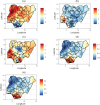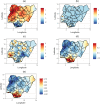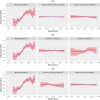Co-morbidity of malaria and soil-transmitted helminths in Nigeria: a joint Bayesian modelling approach
- PMID: 40170071
- PMCID: PMC11963695
- DOI: 10.1186/s40249-025-01276-x
Co-morbidity of malaria and soil-transmitted helminths in Nigeria: a joint Bayesian modelling approach
Abstract
Background: Malaria and soil-transmitted helminths (STH) represent significant public health challenges in tropical regions, particularly affecting children and impeding development. This study investigates the co-morbidity of malaria, caused by Plasmodium spp., and STH infections, including Ascaris lumbricoides(roundworm), Ancylostoma duodenale and Necator americanus (hookworm), and Trichuris trichiura(whipworm), in Nigeria.
Methods: We utilized malaria prevalence data from the Nigeria Malaria Indicators Survey (NMIS) for the years 2010 and 2015 and STH prevalence data from the Expanded Special Project for Elimination of Neglected Tropical Diseases (ESPEN) portal, covering the years 1978-2014. A Bayesian coregionalization model was employed to analyze the prevalence and incidence of malaria and STH, linking these data to climatic factors such as temperature and precipitation. The study's findings highlight significant co-morbidity between malaria and STH, particularly in the southsouth and southeast regions.
Results: Our analysis reveals notable regional disparities: malaria prevalence is highest in the northwest and north-central regions, while Ascaris lumbricoides is widespread in both northern and southern states. Ancylostoma duodenale and Necator americanus(Hookworm) are predominantly found in the southwest, and Trichuris trichiura, though less prevalent, is significant in specific areas. Substantial co-morbidity between malaria and STH was observed, particularly in the South-South and southeast regions, indicating a compounded health burden. Furthermore, climatic factors significantly influence disease distribution; higher temperatures correlate with increased malaria prevalence, although temperature has a minimal effect on STH prevalence and incidence. In contrast, precipitation is positively associated with both malaria and STH incidence.
Conclusions: These findings enhance our understanding of the spatial distribution and risk factors associated with malaria and STH in Nigeria, providing vital insights for the development of public health policies and targeted intervention strategies.
Keywords: Ascaris lumbricoides; Trichuris trichiura; Climate; Coregionalization; Hookworm; Malaria; Nigeria; Soil-transmitted helminths.
© 2025. The Author(s).
Conflict of interest statement
Declarations. Ethics approval and consent to participate: This study was conducted under ethical guidelines. As this research relied on secondary data, consent from individual participants was not required. All data used were anonymized to protect participant privacy. Consent for publication: Not applicable. Competing interests: The authors declare that they have no competing interests related to this study. There are no financial or personal relationships that could influence the research outcomes.
Figures







Similar articles
-
Bayesian geostatistical model-based estimates of soil-transmitted helminth infection in Nigeria, including annual deworming requirements.PLoS Negl Trop Dis. 2015 Apr 24;9(4):e0003740. doi: 10.1371/journal.pntd.0003740. eCollection 2015 Apr. PLoS Negl Trop Dis. 2015. PMID: 25909633 Free PMC article.
-
Soil surveillance for monitoring soil-transmitted helminths: Method development and field testing in three countries.PLoS Negl Trop Dis. 2024 Sep 6;18(9):e0012416. doi: 10.1371/journal.pntd.0012416. eCollection 2024 Sep. PLoS Negl Trop Dis. 2024. PMID: 39241051 Free PMC article.
-
Prevalence and distribution pattern of malaria and soil-transmitted helminth co-endemicity in sub-Saharan Africa, 2000-2018: A geospatial analysis.PLoS Negl Trop Dis. 2022 Sep 30;16(9):e0010321. doi: 10.1371/journal.pntd.0010321. eCollection 2022 Sep. PLoS Negl Trop Dis. 2022. PMID: 36178964 Free PMC article.
-
Prevalence and distribution of soil-transmitted helminth infections in Nigerian children: a systematic review and meta-analysis.Infect Dis Poverty. 2018 Jul 9;7(1):69. doi: 10.1186/s40249-018-0451-2. Infect Dis Poverty. 2018. PMID: 29983115 Free PMC article.
-
A systematic review and meta-analysis of human and zoonotic dog soil-transmitted helminth infections in Australian Indigenous communities.PLoS Negl Trop Dis. 2022 Oct 24;16(10):e0010895. doi: 10.1371/journal.pntd.0010895. eCollection 2022 Oct. PLoS Negl Trop Dis. 2022. PMID: 36279298 Free PMC article.
References
-
- Babamale OA, Ugbomoiko US, Heukelbach J. High prevalence of Plasmodium falciparum and soil-transmitted helminth co-infections in a periurban community in Kwara State. Nigeria J Infect Public Health. 2018;11:48–53. - PubMed
-
- Soil-transmitted helminth infections https://www.who.int/news-room/fact-sheets/detail/soil-transmitted-helmin.... Accessed 20 May 2024.
-
- Maryam S. Neglected tropical diseases in Nigeria: situation analysis. Adv Soc Sci Res J. 2016. 10.14738/assrj.310.2235.
MeSH terms
Substances
LinkOut - more resources
Full Text Sources
Medical
Miscellaneous

